 |
||
|
||
| ||
 Contents
On the Xmas eve Microsoft released the long-awaited API DirectX 9.0 which became a real Xmas gift. The next day ATI Technologies launched new drivers certified by Microsoft for DX9 for the RADEON 9500-9700 line, because only this line supports the DX9 on the hardware level. We couldn't omit such a significant event and prepared a review in two parts. In the first part we will publish test results for the whole line of 5 cards in a great deal of game tests, while in the second we will carry out a very interesting analyses of these cards running in some synthetic tests from the new RightMark3D suite which is due to come onto the scene very soon. This packet is entirely meant for DX9 cards though some tests can work on DX81 cards as well. So, today we will look at five cards from the new ATI's line under the DirectX 9.0 in the game benchmarks. Unfortunately, there are no benchmarks (or games) for the DX9, that is why we will study the R9500-9700 line as a whole; earlier we reviewed each card separately. Here they are: Theoretical materials and reviews of video cards which concern functional
properties of the VPU
Earlier we saw that the new line of the Canadian company proved to be very good. It's a pity though that the junior card RADEON 9500 64MB doesn't justify its price, because in the tests it loses much to the GeForce4 Ti 4200 in speed without AA and anisotropy (in these modes the gain is too small as well). That is why the maximum price for such card is $100-110 instead of $150-160 they are currently selling at. The rest of the cards are quite successful, especially RADEON 9500 PRO. Unfortunately, the maximum bandwidth of this card is 128 bits instead of 256. ATI has perfectly redesigned the PCB. The buffer compression has an excellent effect in case of AA! In our article everything is described in detail, we can consider even a virtual 256-bit bus in case of AA. Today we will look again at all the performance correlations at different loads. As for the R9700 and R9700PRO, the former successfully fights against the GeForce4 Ti 4600 in price and speed, and the latter is beyond any competition at all. Until the launch of the GeForce FX, the RADEON 9700 PRO remains a leader. Before the tests have a look at the cards themselves. Here are the price niches they belong to:
Have you noticed that all the cards except the last one work at the same frequencies? It's interesting from the standpoint of using the same core for the whole line. Cards
I mentioned above that 4 out of 5 cards have their cores working at 275 MHz. Our tests and this fact imply that ATI found an excellent way to use the dies unable to run at 325 MHz. It proves that the prime cost of the whole line is not so high as we could think early in autumn 2002. Soft9700Now we are going to speak about the Soft9700. When we just starting examining the RADEON 9500 and found out that it was based on the same die R300, Aleksei Nikolaichuk (AKA Unwinder, developer of the RivaTuner) and me suspected that the chip was chopped at the software level. The situation with the memory buses is clear: the RADEON 9700/Pro and 9500 128MB have 256 bits, the 9500 64MB and 9500PRO have 128 bits. But it's was quite vague about normal 8 pipelines. I also mentioned about the way of using 8 pipelines on the hardware level by a bit of resoldering. And now we have found a software way! Aleksei has been working on it for 3 weeks and has finally found the protection and the way to avoid it! With the patch for the RivaTuner you can modify one of the files of the distributive of the drivers and install the drivers from this distributive! We tested both cards - RADEON 9500 64MB and 9500 128MB, and got a positive result: the first one was almost the RADEON 9500 PRO, while the other behaved like RADEON 9700. The results differ from the original ones by a couple of tenths of FPS, that is why it makes no sense to show them on the diagrams separately. Note that both R9500 cards can overclock, that is why it's easy to get even RADEON 9700 PRO! The developer of the RivaTuner promises to integrate this patch into the next version of the utility so that everyone can use it. A bit on connection between the hardware redesigning (resoldering) and software one. In case of the R300 PCI DeviceID is programmed in the BIOS. In case of the R9500PRO/R9700(PRO) - both high and low bytes are programmed, that is why if you flash the BIOS from R9500 into the R9500PRO the driver will identify the card as R9500 and use only 4 pixel pipelines. In the R9500 the resistor on the chip forbids programming of the high byte of PCI DeviceID making impossible to change the ID in the BIOS. But nothing prevents from forcing ID on the drivers level. That's exactly what we did. All the other aspects are already covered in the reviews listed above. OverclockingFor overclocking of the RADEON 9500 PRO we used the modified BIOS with the protection from changing frequencies was removed. It can be taken at http://www.rage3d.com. For speeding up the RADEON 9700 PRO we used the Hercules card with the modernized chip: 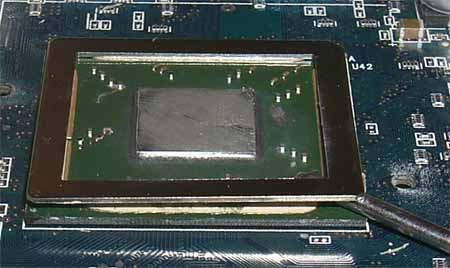 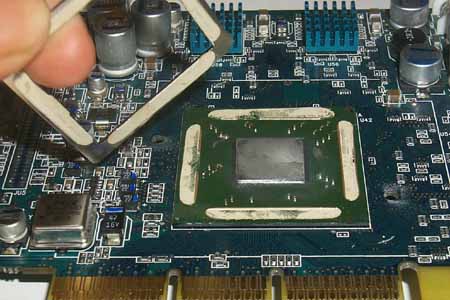 With the frame removed the cooler is pressed tightly to the chip and we get 385 MHz instead of 360 MHz (to make it more stable I lowered the frequency to 380 MHz). The memory was running stably at 350 (700) MHz. All the other cards were overclocked to 325/310 (620) MHz in order to compare the resultant performance with the RADEON 9700 PRO (it's curious to set equal frequencies to look at the effect of four additional pipelines and/or the bus extension to 256bits). Test system and driversTestbed:
The test system was coupled with In the tests we used ATI's drivers 6.255 (DirectX 9.0 used). VSync was off in the drivers, texture compression was off in the applications. Texture detail level set to High Quality. For comparison we used results of the following video cards:
Drivers' settingsThe DirectX 9 drivers are already released, that is why we can study operation of the ATI's cards supporting DX9. There are no gaming tests for this API, that is why we use the old tests but under the DX9. All the settings of the drivers are described in the reviews given above (the drivers 6.255 do not differ in this respect). Test resultsAleksei Nikolaichuk (AKA Unwinder, developer of RivaTuner) helped me modify operation of the RADEON 9700 by cutting the bus to 128bits (this is actually the RADEON 9500 PRO). The tests will be given further, and the small difference between the R9700 128bit and R9500 PRO proves again that the latter has a 128-bit bus. Also look at the tests of 4 out of 5 cards running at 325/310 MHz, i.e. at the frequencies of the RADEON 9700 PRO. The comparison shows that the memory bus and the crippled core (4 or 8 pipelines) do influence the results. All the cards except R9700 and R9700PRO were compared with the GeForce4 Ti 4200-8x priced at about $200 for the beginning of 2003 (i.e. the RADEON 9500 64 and 128MB are cheaper). The R9700 and 9700PRO are compared with the Ti 4600 (in first case the prices are comparable, and in the second one there is no one to confront with). In some tests we compared operation of several cards in 16- and 32-bit colors for estimation of balance. 3D graphics, 3DMark2001 - game tests3DMark2001, 3DMARKS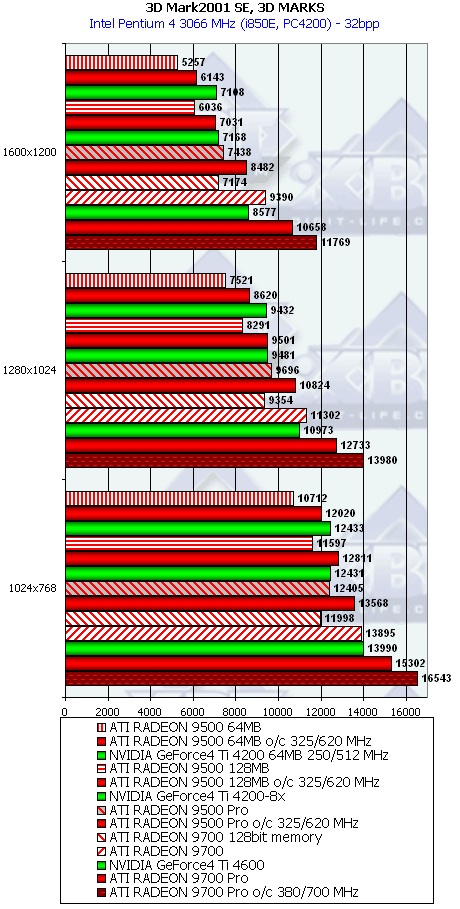
 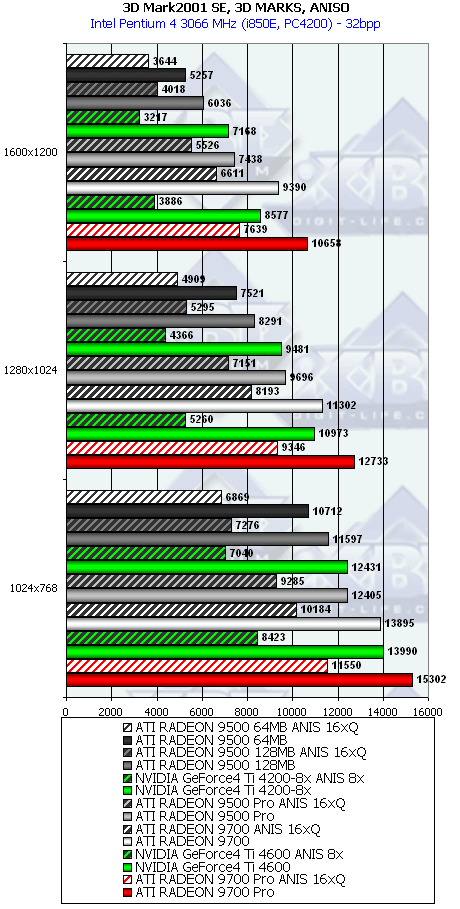
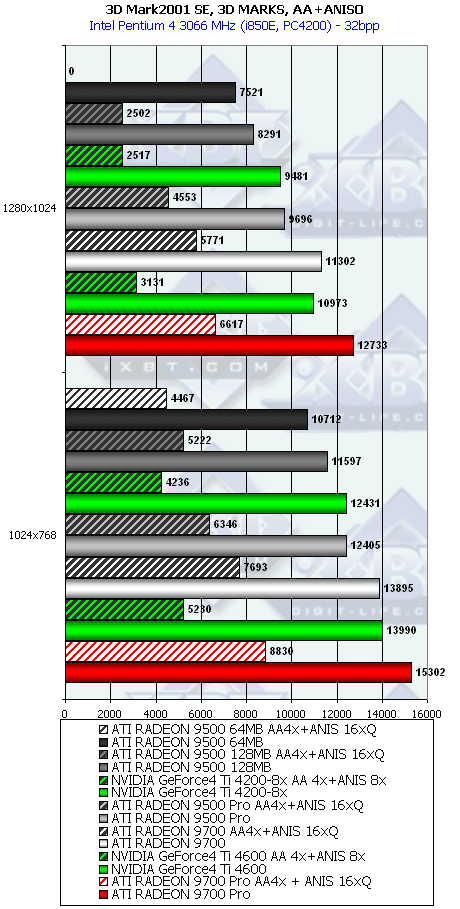 These tests give just a general idea. The full analyses can be carried out only in separate tests. 3DMark2001, Game1 Low details
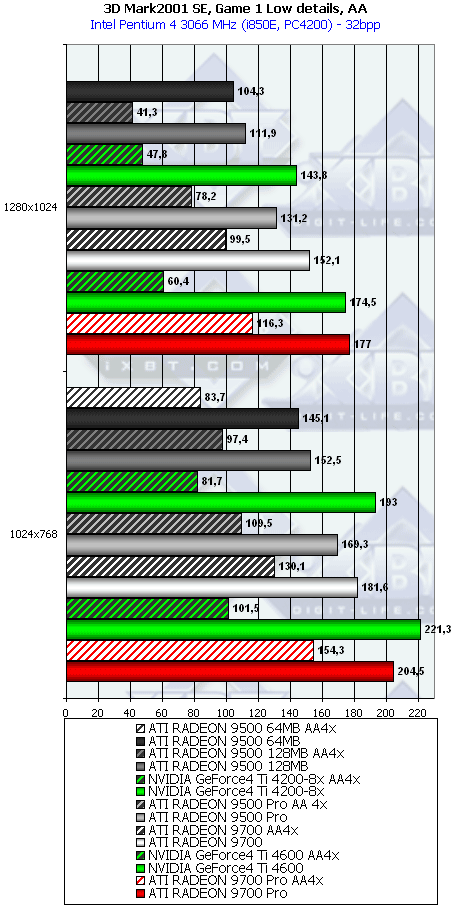 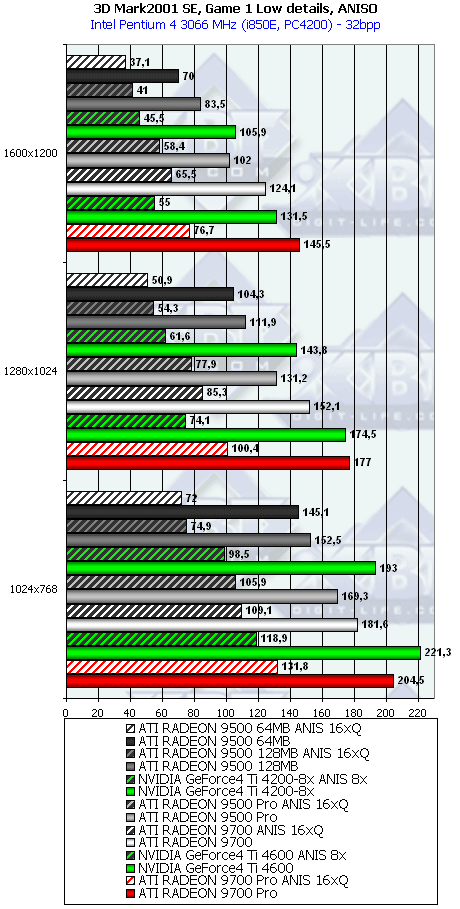
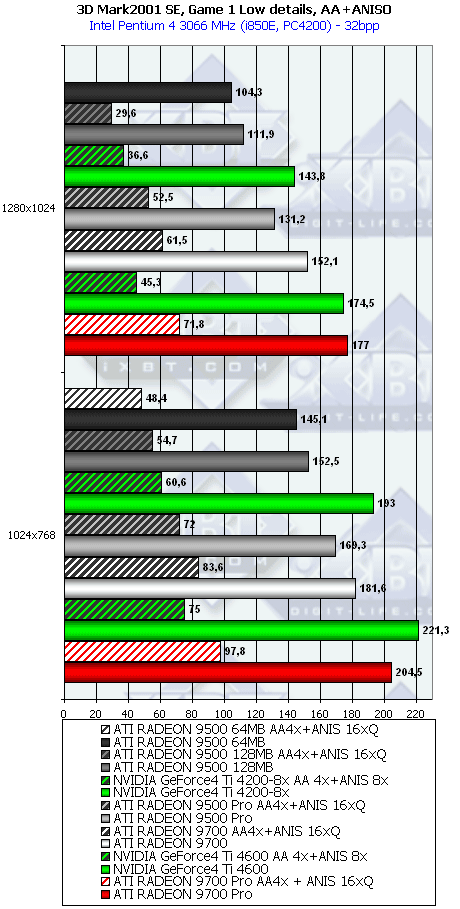 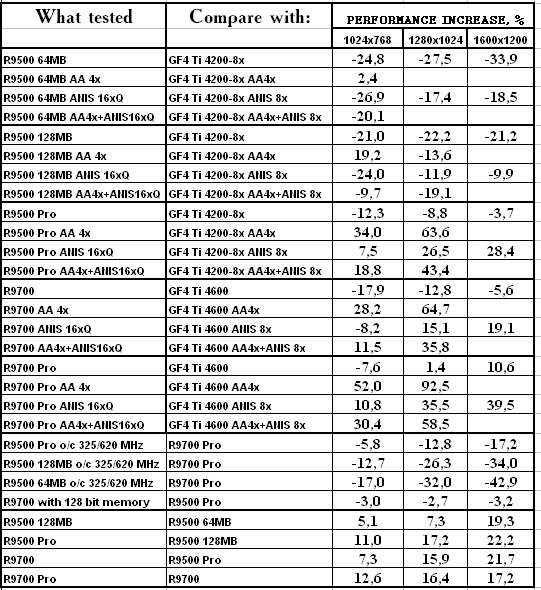
 What can we see? The R9500 64MB falls far behind (except the AA mode), a little better results of the 128MB R9500 and excellent scores of the R9500 PRO in the modes with AA and/or anisotropy. The monsters R9700 and R9700PRO fight successfully against their competitor also in heavy conditions of AA and/or anisotropy. The R9500PRO lost a lot because of the crippled bus, and it also is the furthest from the R9500 128MB despite the 256bit bus of the other. The R9500 64MB (128bit) is the most balanced card, such a bus is quite
enough for its 4 rendering pipelines, except for AA or anisotropy. The
R9700 slows down with the transition from 16 to 32 bits in spite of its
256bit bus, i.e. 8 pipelines working at 275 MHz need a tad faster memory.
3DMark2001, Game2 Low details
 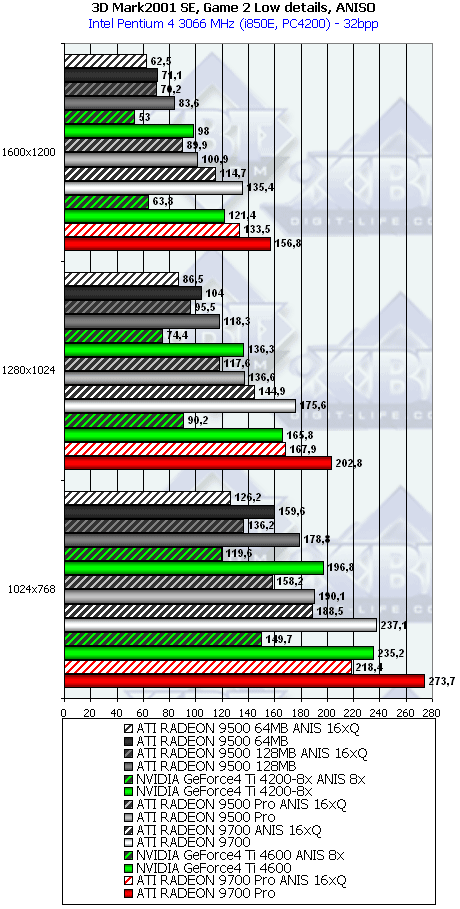
 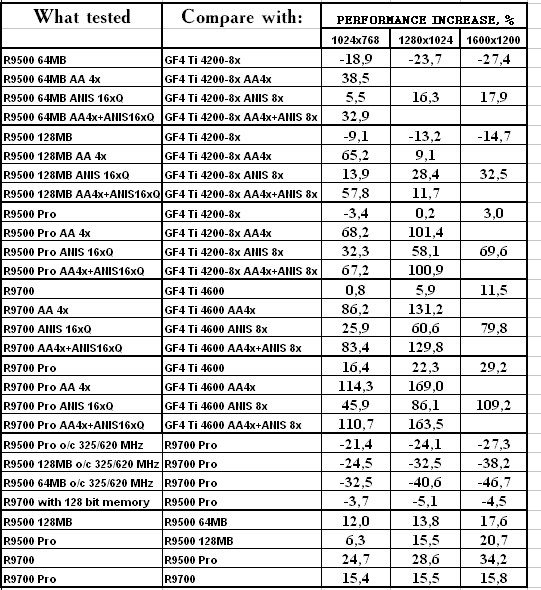
 Here the R9500 64MB performed better, and although it still loses much without AA and anisotropy, we must account for the price difference and a brilliant victory with the AA and anisotropy enabled. The R9500 128MB had it even better. Comparison of the 16 and 32 bit colors prove what I said above about
good balance of the R9500 64MB compared to the R9700.
3DMark2001, Game3 Low details
 
 
 Well, the situation is excellent for the whole line. 3DMark2001, Game4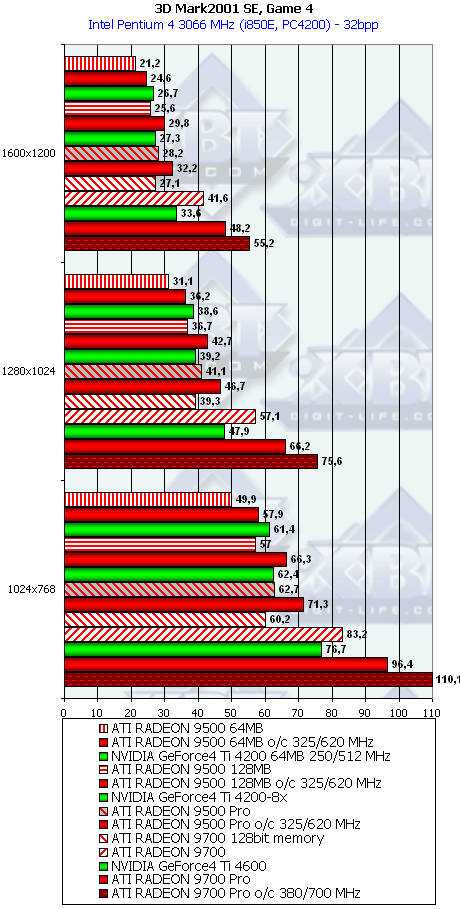
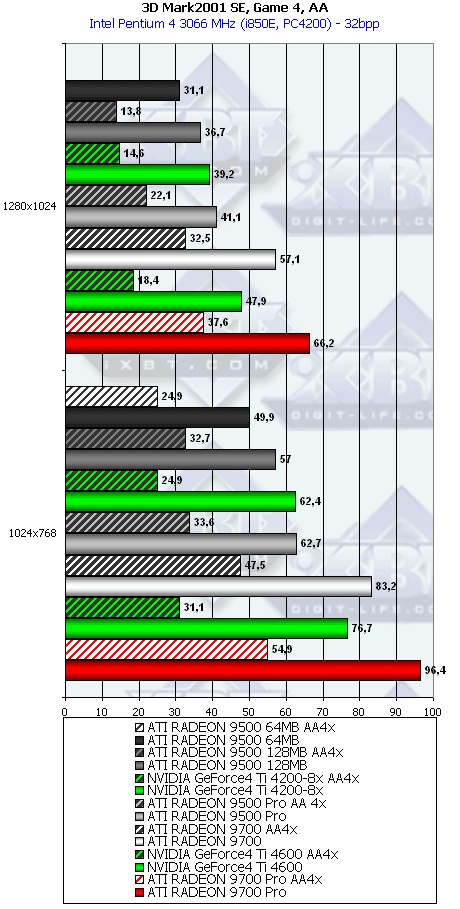 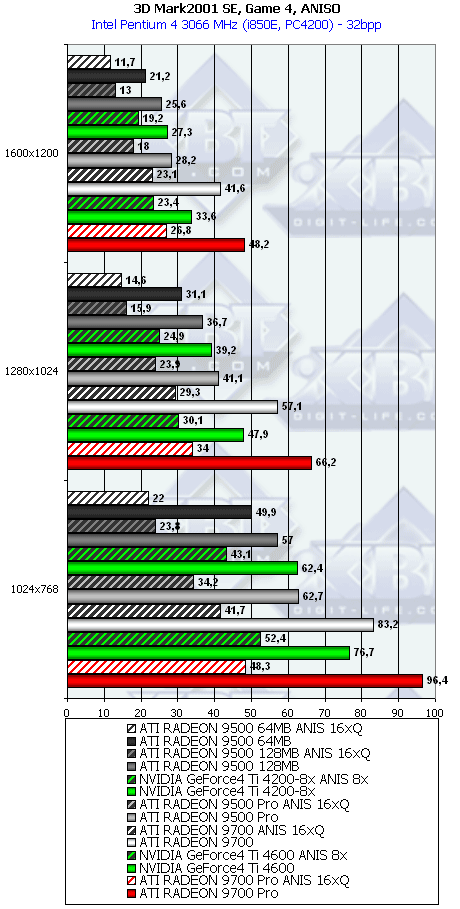
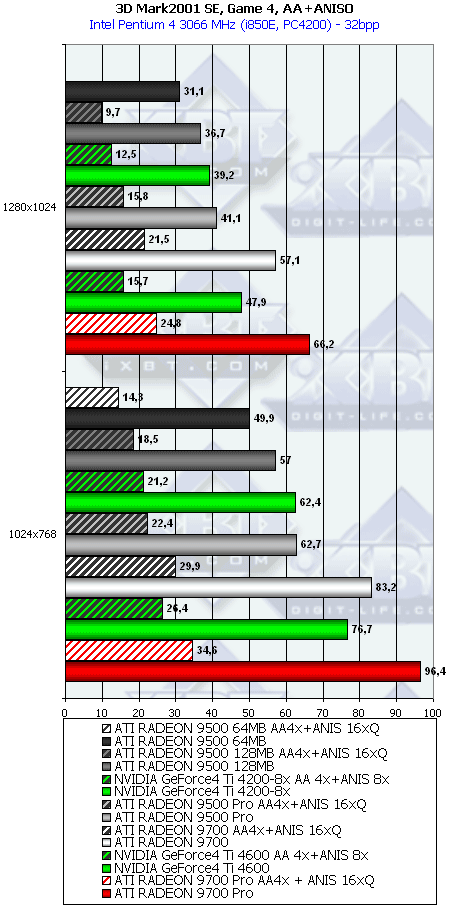 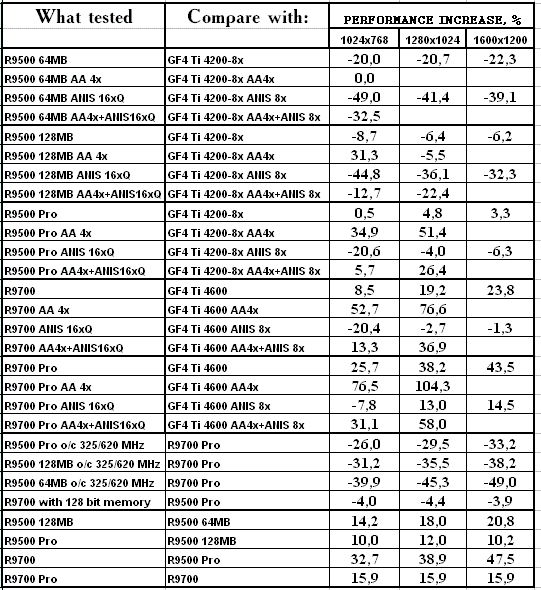
 The test which used to be the best test for ATI is now a stumbling block for the R9500-R9700 line. Probably, NVIDIA optimized operation of its cards so thoroughly that even the usage of the trumps like AA and/or anisotropy doesn't allow for the expected effect. Note that here it is the anisotropy that makes the R9500-9700 slow down, while the decrease of the GeForce4 Ti is not as great as before. I think something's wrong here. Because of a great number of effects this filtering type can hardly be noticed. That is why it's possible to play some tricks. It's not a hint, I just have such impression about NVIDIA. As for the speed decrease of the R9500-R9700 caused by the anisotropy, this test loads the video memory a lot, and as we know, this type of filtering also loads the memory much in case of all ATI's cards (the core is less loaded compared to the GeForce). Hence such drops. 3D graphics, game testsFor estimation of 3D performance in games we used the following tests:
Note that the drivers 6.255 work incorrectly with the mouse pointer in OpenGL applications causing jerking in games of the RADEON 9500 PRO and higher. Somehow, it doesn't affect the R9500. It can be cured by disabling acceleration of the mouse pointer in the display settings (move the acceleration pointer to the left by 1). It doesn't affect the 3D speed but the mouse pointer moves a little slower. Quake3 Arena, Quaver
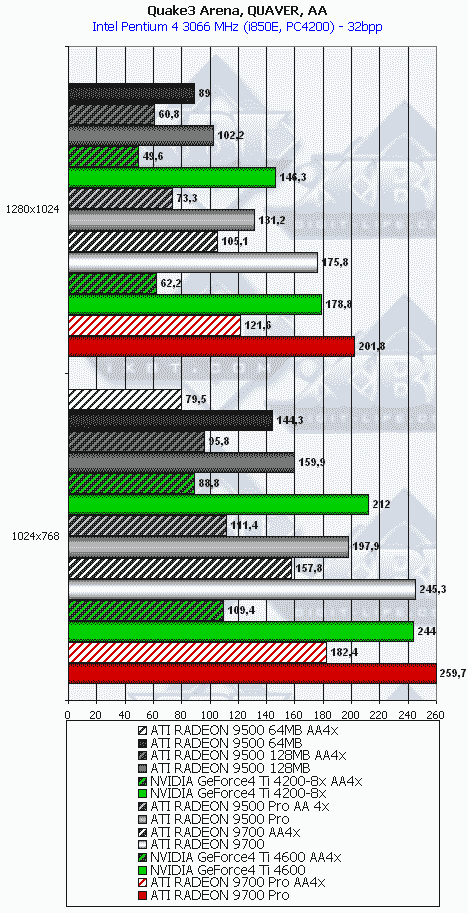 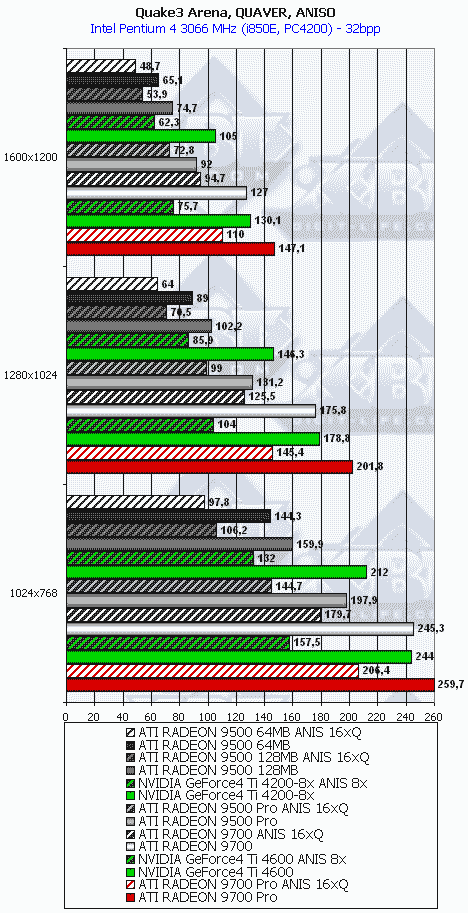
  As always, NVIDIA has its OpenGL drivers optimized for the engine of Quake3, that is why in this test only the RADEON 9500 PRO is a bright leader. Serious Sam: The Second Encounter, Grand Cathedral
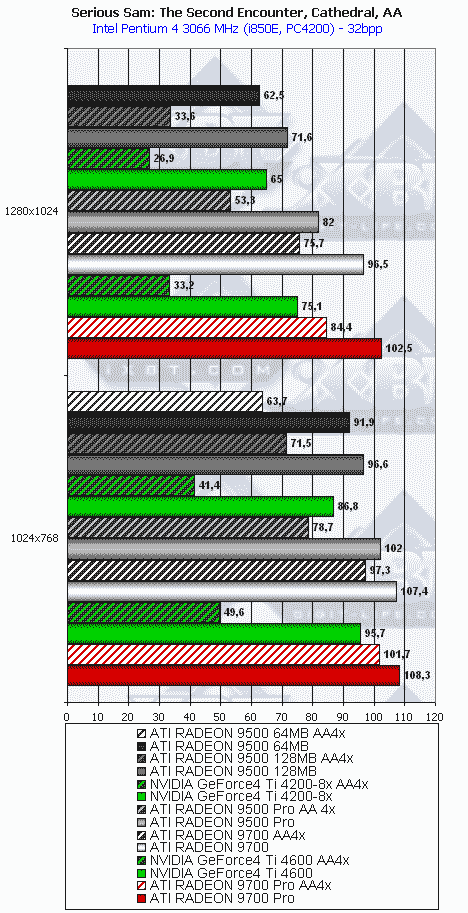 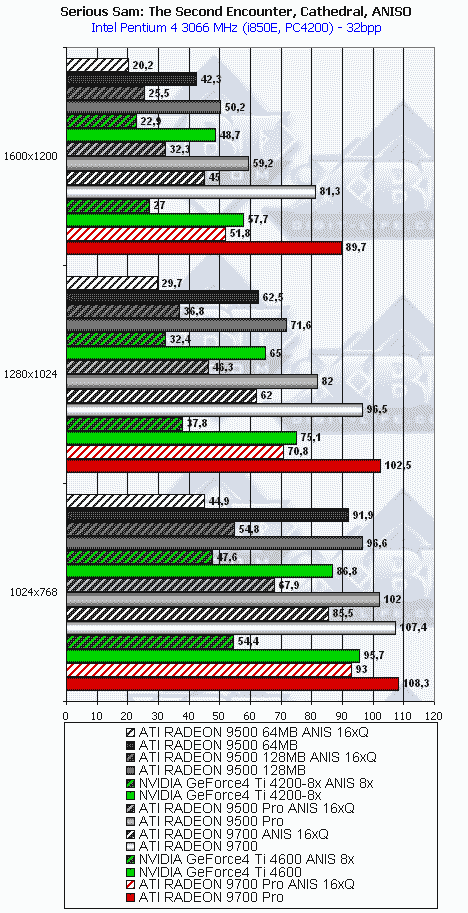
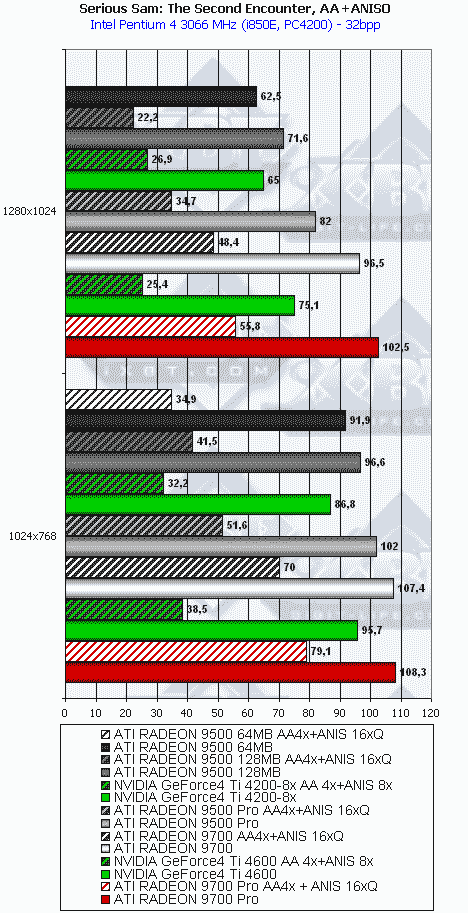  Here is the evidence of the optimization of the drivers for this game. Look at the smooth victory of the whole line, even though the settings and scenes are much tougher than in the Quake3. Return to Castle Wolfenstein (Multiplayer), Checkpoint
 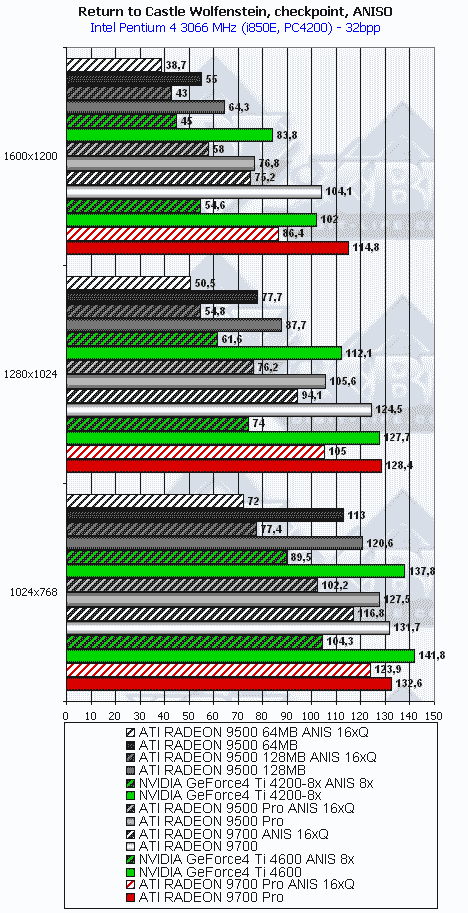
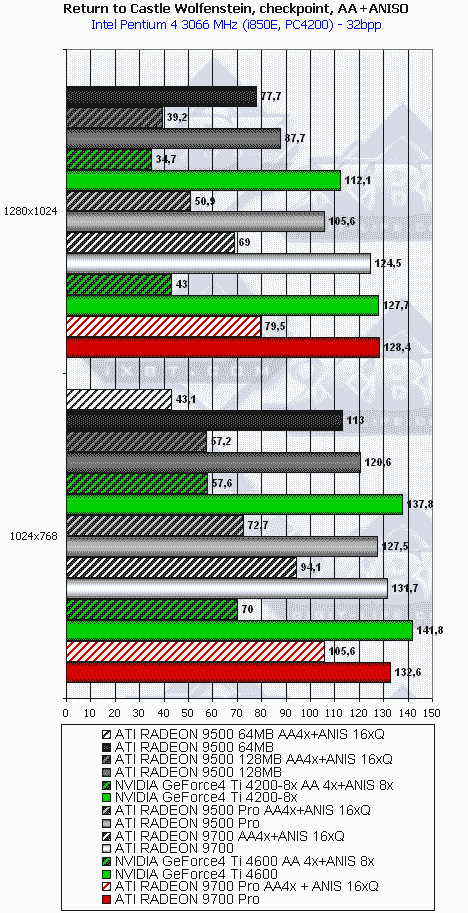 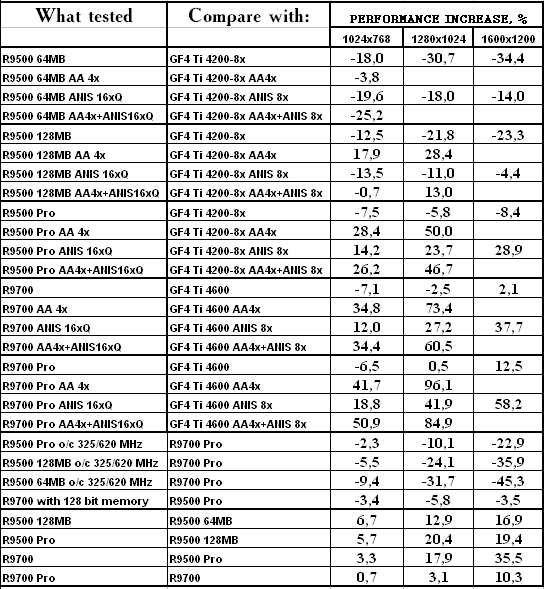 Again the engine of Quake3, and again the GeForce4 Ti comes forward. However, the test is more dependent on the processor, that is why the ATI's cards suffer less from the anisotropy. Also remember that exactly in this game the anisotropic quality of the R9500-9700 falls down markedly, almost to the level of R8500 on the surfaces of 45 degrees (though now it's 60 degrees). Comanche4 DEMO
 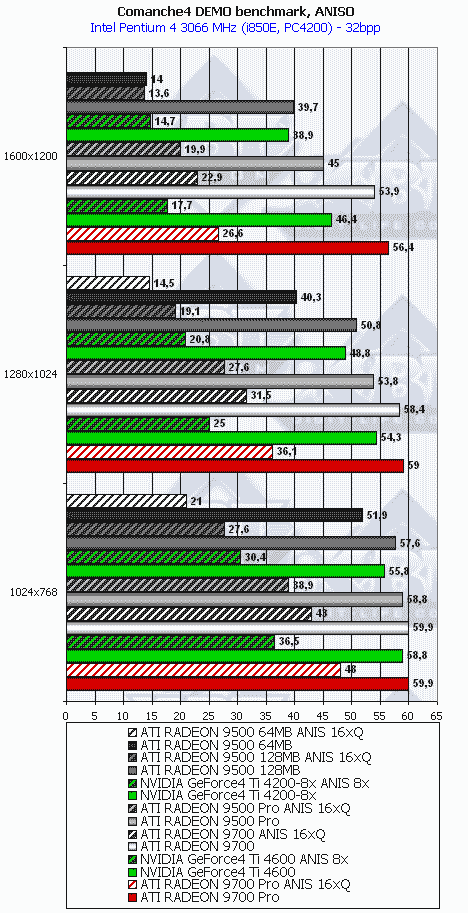
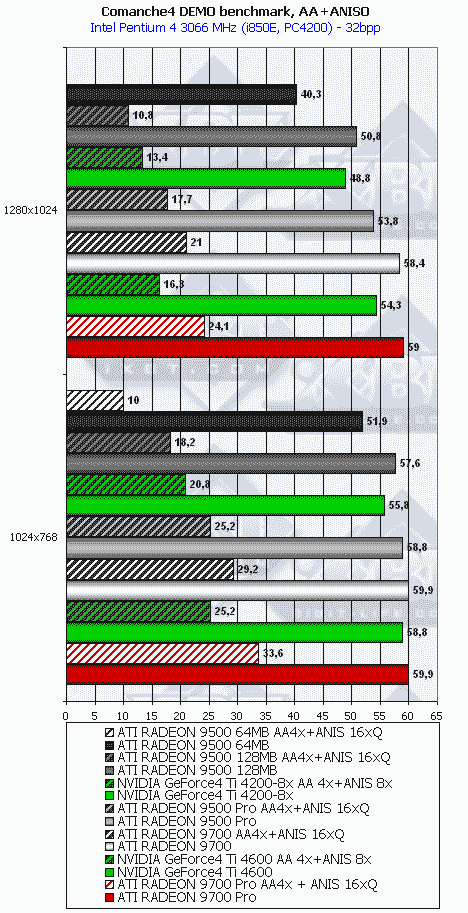  The RADEON 9500 PRO, as well as R9500 128MB have very good scores. 64 MB of the R9500 let down this card in this test (Comanche4 doesn't like cards with such memory size though, judging by the graphics, 64 MB are quite enough for all textures and other things). Unreal Tournament 2003 DEMO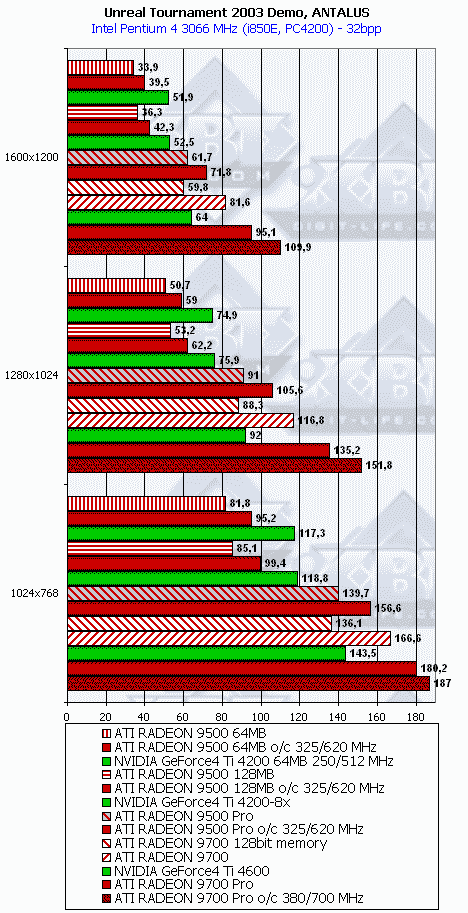
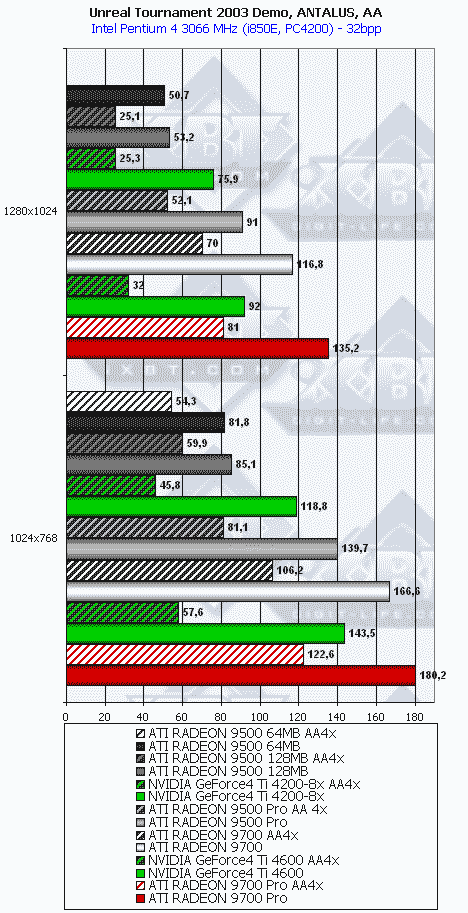 
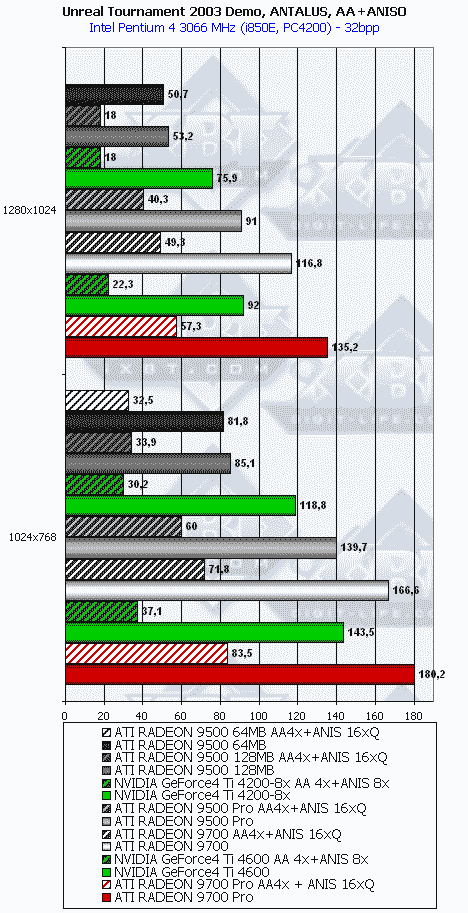  Well, 4 vertex pipelines of all the cards of the ATI's line boost the performance greatly! AquaMark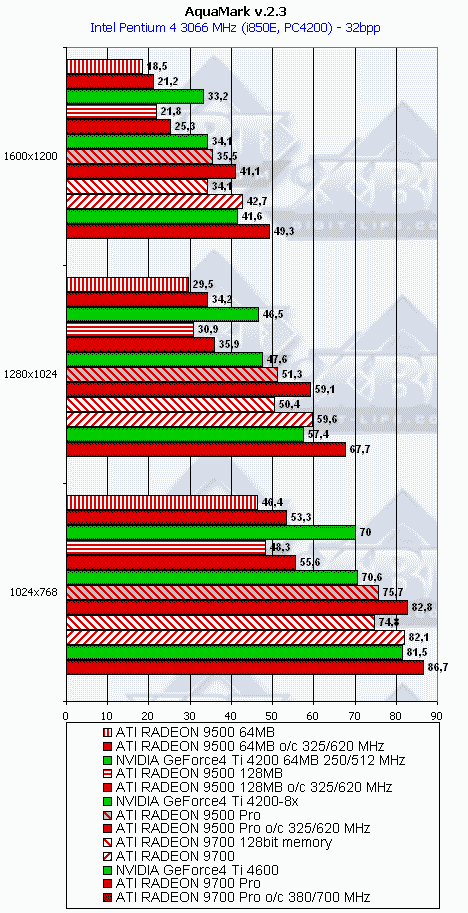
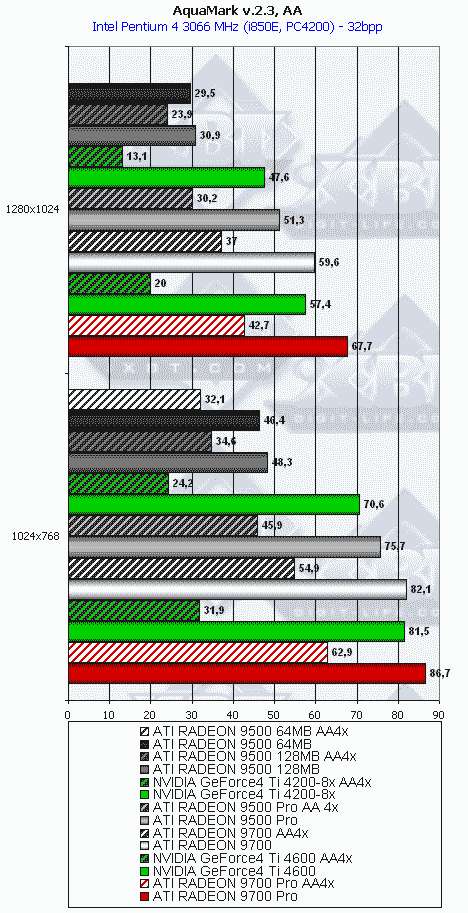 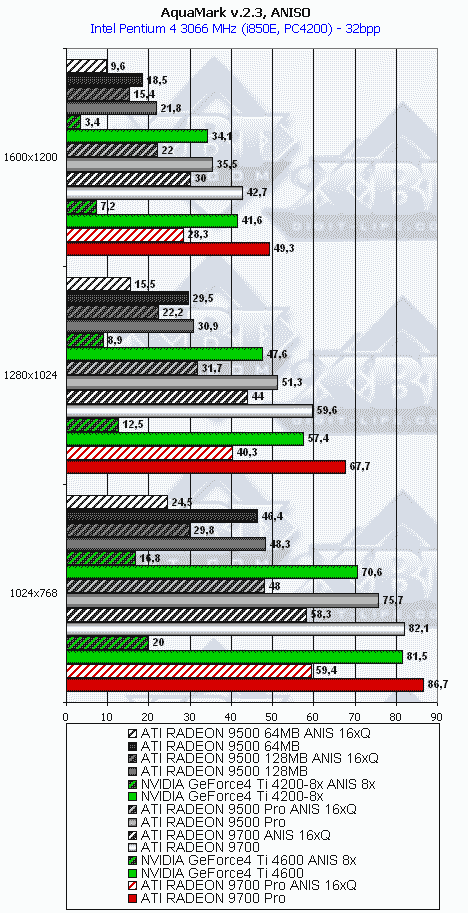
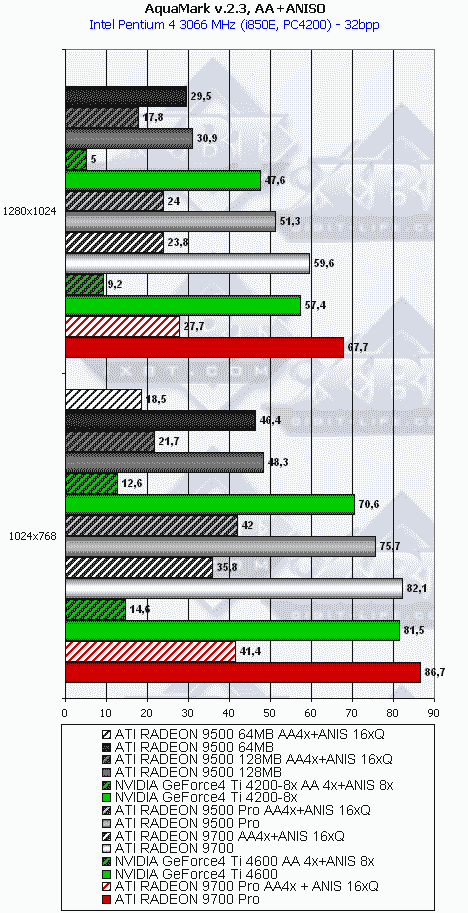 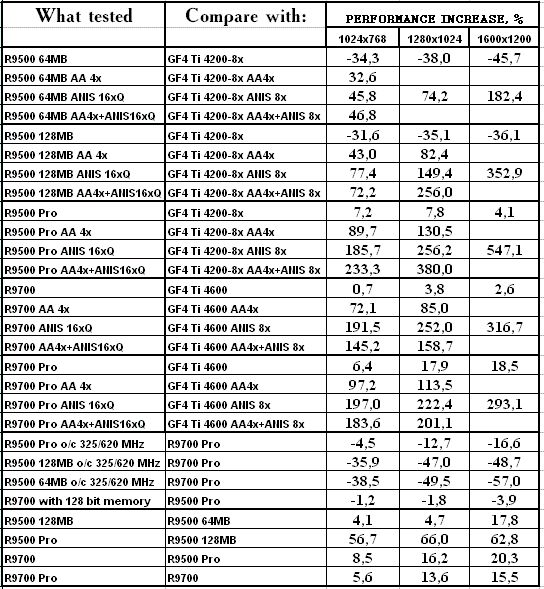 The ATI's fans must be really happy now. This game uses numerous polygons with semitransparent textures to create an effect of depth of water. Apparently, the NVIDIA cards also process these polygons with anisotropy, hence such a dramatic drop. The ATI's cards are more tricky here, and we do agree: why to do unnecessry work. RightMark 3D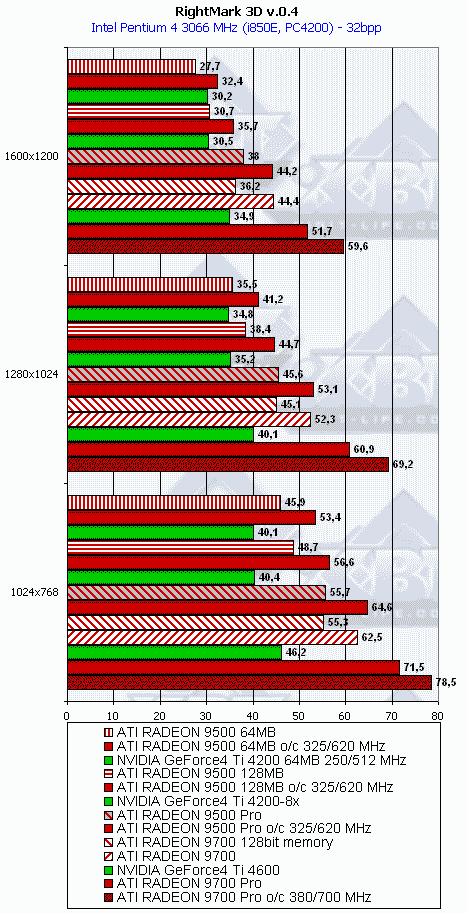
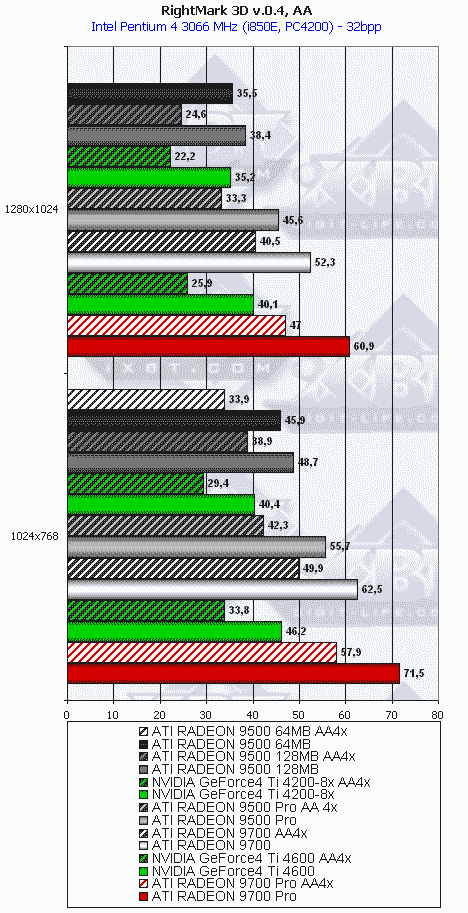 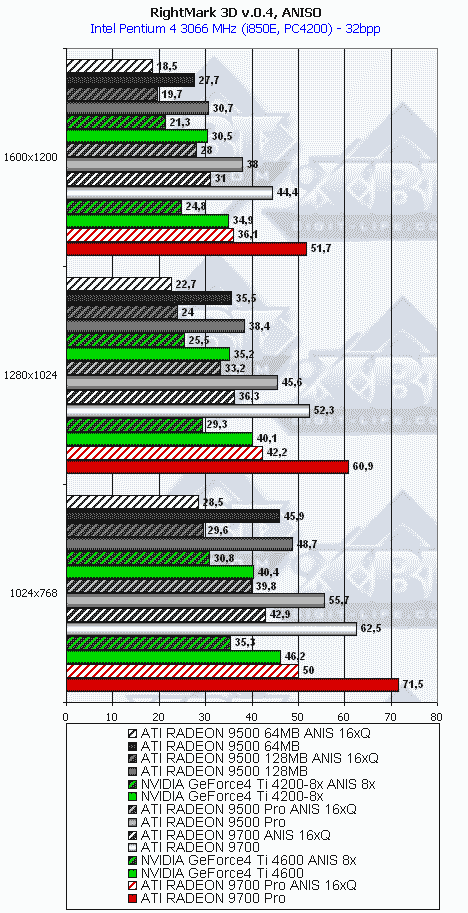
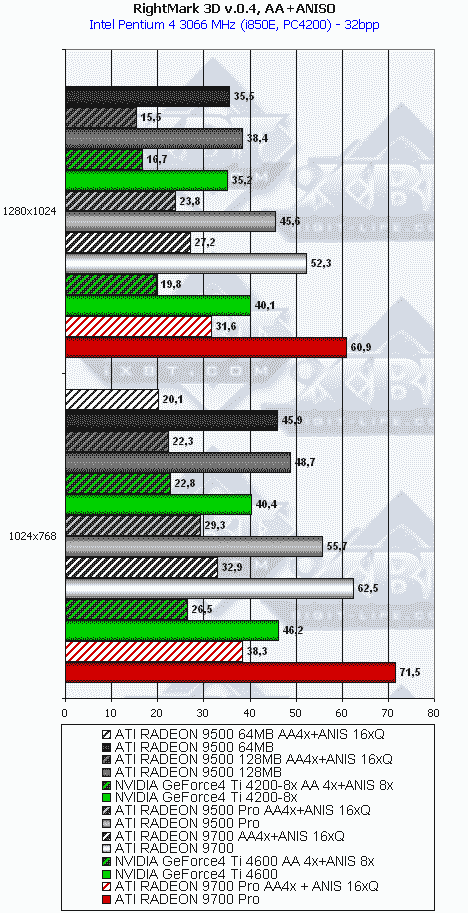  This test, which loads the accelerators with work with shaders a lot also shows that the R9500-9700 have no problems here, the speed of execution of the DirectX 8.1 1.1 shaders is very high. Taking into account that this scene doesn't have sloping surfaces, and the ATI's anisotropy is implemented by 100%, I'm really glad the R9500 PRo and higher outdo their rivals at this load. Code Creatures Benchmark Pro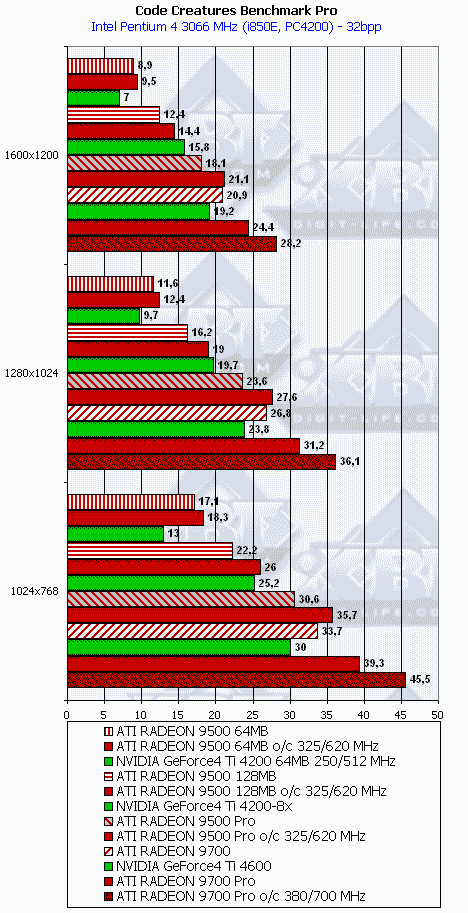
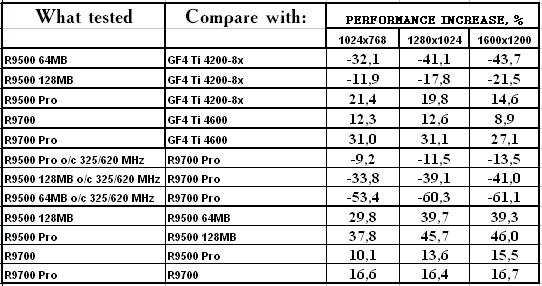 This test is so tough that it makes no sense to enable AA and anisotropy. So, the speed is very low. The R9500 loses to its rivals (4 pipelines are obviously not enough for such complex scenes), and the changes take place starting from the R9500 PRO. There must be a powerful chip in the first place, and only then a wide memory band, though we can estimate a 256-bit bus according to the gap between the R9700 PRO and Ti 4600. ConclusionToday we don't touch the quality issues, it will be discussed in the YUAN's RADEON 9700 PRO review which will soon hit the streets. In the second part you can take a look at the unique tests for DirectX 9.0 where we will estimate operation of the shaders 2.0.
In summary, I must say that operation of the drivers 6.255 under DirectX
9.0 was flawless but for the situation with the mouse pointer in the OpenGL
when we had to accelerate it. On the whole, the speed of the games and
tests in the DirectX 9.0 didn't fall down. I hope the programmers at ATI
will correct the error as soon as possible.
Andrey Vorobiev (anvakams@ixbt.com)
Write a comment below. No registration needed!
|
Platform · Video · Multimedia · Mobile · Other || About us & Privacy policy · Twitter · Facebook Copyright © Byrds Research & Publishing, Ltd., 1997–2011. All rights reserved. | |||||||||||||||||||||||||||||||||||||||||||||||||||||||||||||||||||||||||||||||||||||||||||||||||||||||||||||||||||||